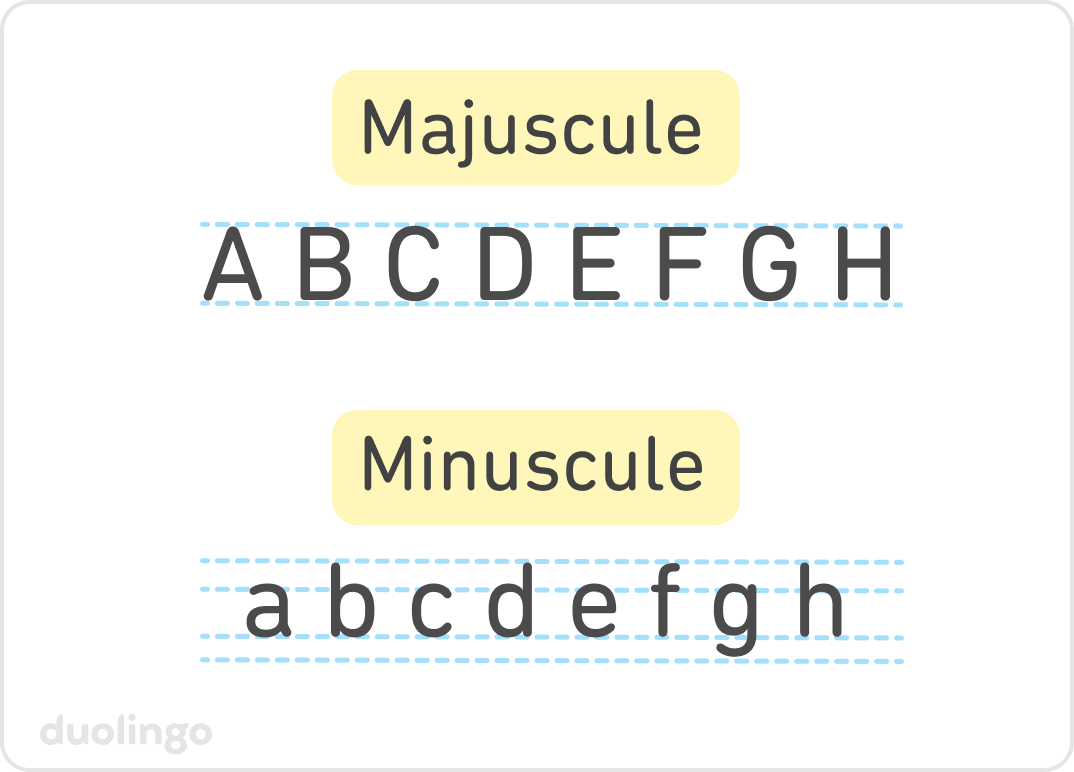Welcome to another week of Dear Duolingo, an advice column just for learners. Catch up on past installments here.
Hi again, dear readers! This week, we’re tackling a question about written language: why some languages use uppercase and lowercase letters.
Our question this week:

Thank you for your letter, In Any Case. For some of us, capital letters are something completely ordinary. However, there are many different writing systems around the world, and languages that use both uppercase and lowercase letters are in fact in the minority. Let’s explore how some writing systems (including alphabets such as the Latin, the Cyrillic, and the Greek) ended up with this distinction.
What are capital letters?
Capital letters—also called uppercase or majuscule—are those where all letters reach the maximum height between two (imagined or real) lines. For lowercase or minuscule letters, we imagine four lines. All minuscule letters reach between the two middle lines, and some might extend above or below these two lines.

The reason we call some styles of letters uppercase and another style lowercase is because of the printing press. In the 15th century, these presses used letters in different sizes and fonts, and each was sorted into actual physical cases (or containers) of typefaces, depending on whether they were majuscule or minuscule letters.
A brief history of capitalization
During the Roman Empire, Latin was frequently used for inscriptions, such as those on the Pantheon or Trajan’s Column in Rome. Since inscriptions were usually carved in stone, it was easier to use straight lines, sharp edges, and only some basic curves. The letters used for this—Roman Square Capitals—are essentially what we now know as capital letters!
The term capital letter also goes back to Latin. It comes from the Latin word caput, meaning “head,” to which the suffix -ālis was added to make it an adjective. So, whether it is because capital letters have a big, capital appearance, or because they head the sentence of our modern script—their name says it all.
1st century: influence of handwriting
TLDR: Capital letters only, but they’re getting curvier
Over time, handwritten manuscripts became more common, and with them, the script began to change: Letters became smaller and rounder, which made them faster to write. By the 1st century, everyday documents were written using this script, called Roman Cursive. While some of its letters are reminiscent of today’s lowercase letters, Roman Cursive was still a majuscule script: These were all considered capital letters!
4th century: uncial and half-uncial
TLDR: One of the first scripts using all lowercase letters
Around the 4th century, a new script became popular: uncial. Like Roman Cursive, from which it originated, it used only rounded capital letters. In contrast to Roman Cursive, uncial was mostly used for books and other official documents.
Another script emerged around the same time, called half-uncial, and despite the name, it isn’t actually based on uncial! Half-uncial was one of the first minuscule scripts: For the first time, there were letters of varying size. Some of them even extended below or above the traditional lines (like the letter “p”).
8th century: mixing it up
TLDR: Lowercase script sprinkled with uppercase letters
We didn’t see a mix of uppercase and lowercase letters until the emergence of the Carolingian script in the 8th century. Having received its name from Charlemagne, Emperor of the Carolingian Empire at the time, this script quickly spread across Europe and remained dominant until the end of the 9th century.
During this time, many old Roman documents were copied to help preserve them, and scribes used a mix of the minuscule Carolingian script and majuscule letters that looked similar to those used in the uncial script.
12th century and beyond: back to the roots (sort of…)
TLDR: From dark Gothic script back to the 8th-century-style
In the 12th century, Blackletter script evolved from the Carolingian script, also mixing uppercase and lowercase letters. It was used until the 15th century, when there was a push for the aesthetic and ideas of ancient Rome. Scholars re-discovered the beautiful lettering in some old manuscripts they assumed were from ancient Rome… but were in fact the copies from the 8th and 9th centuries in Carolingian minuscule 👀
So the Renaissance scholars adapted and refined the (medieval) Carolingian script, adding to it capital letters similar to the Roman Square Capitals. The result is basically the style of writing we use today!
Why are capital letters used differently across languages?
During those first centuries of the combined uppercase and lowercase scripts, there were no rules about when to use each style. Capital letters were often chosen for words like names or anything else that seemed worthy of special attention.
However, as time went on, standards began to emerge. Between the 17th and 19th centuries, a lot of dictionaries were published. During this time, language academies like the Académie française (for French) and the Real Academia Española (for Spanish) were founded and began standardizing spelling, grammar, and capitalization. Because institutions were founded at different times and focused on different languages, the result was that standards varied significantly across languages! (Not to mention that some languages, like English, didn’t have official standards or institutions at all.)
Many languages have undergone or still undergo spelling reforms, so capitalization standards have changed over time, even for a single language. For example, English used to capitalize many common nouns (like in the Constitution of the U.S.), but this practice didn’t stick. Today, German is the only major language written in the Latin alphabet that still capitalizes all nouns!
| Proper nouns (like “Lily,” “Brazil”) | Common nouns (like “girl,” “country“) | Languages (like “Korean”) | Pronoun “I” | Formal pronouns | |
|---|---|---|---|---|---|
| English | ✅ | ✖️ | ✅ | ✅ | N/A |
| French | ✅ | ✖️ | ✖️ | ✖️ | ✖️ |
| German | ✅ | ✅ | ✅ | ✖️ | ✅ |
| Italian | ✅ | ✖️ | ✖️ | ✖️ | ✅ |
| Norwegian | ✅ | ✖️ | ✖️ | ✖️ | ✅ |
| Spanish | ✅ | ✖️ | ✖️ | ✖️ | ✖️ |
Capitalize on your knowledge of lettercase
Even if it’s not obvious today—capital letters were once the standard, and our lowercase letters are a newer addition. Today, capitalization rules differ wildly between languages, so learning a new language often also means discovering new patterns of capitalization!
For more answers to your language and learning questions, get in touch with us by emailing dearduolingo@duolingo.com.
